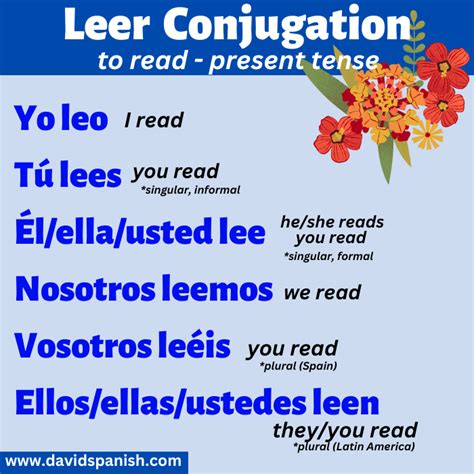The Spanish verb "leer" (to read) is a fundamental part of the language, and mastering its various forms is crucial for effective communication. One of the most commonly used forms of "leer" is the imperfect tense, which can be a bit tricky for non-native speakers to grasp. In this article, we will delve into the world of the imperfect form of "leer" in Spanish, exploring its conjugation, usage, and practical examples to help you improve your language skills.

What is the Imperfect Tense in Spanish?
The imperfect tense (pretérito imperfecto) in Spanish is used to describe ongoing or repeated actions in the past. It is often translated to English as "was reading," "used to read," or "would read." The imperfect tense is an essential aspect of Spanish grammar, as it allows speakers to convey a sense of continuity or habit in the past.
Conjugation of Leer in the Imperfect Tense
The conjugation of "leer" in the imperfect tense is relatively straightforward. The verb endings are as follows:
- -ía (yo)
- -ías (tú)
- -ía (él/ella/usted)
- -íamos (nosotros/as)
- -íais (vosotros/as)
- -ían (ellos/as)
Here are the conjugations of "leer" in the imperfect tense:
| Subject | Conjugation |
|---|---|
| Yo | leía |
| Tú | leías |
| Él/ella/usted | leía |
| Nosotros/as | leíamos |
| Vosotros/as | leíais |
| Ellos/as | leían |

Using the Imperfect Form of Leer
The imperfect form of "leer" is used to describe ongoing or repeated actions in the past. Here are some examples:
- Yo leía un libro cada noche antes de dormir. (I used to read a book every night before going to bed.)
- Ella leía novelas románticas durante el verano. (She used to read romance novels during the summer.)
- Nosotros leíamos el periódico todos los días. (We used to read the newspaper every day.)
Practical Examples and Exercises
To help you practice using the imperfect form of "leer," here are some exercises and examples:
- Complete the following sentences with the correct conjugation of "leer" in the imperfect tense:
- Yo ____________________ un libro de historia en la biblioteca. (I used to read a history book in the library.)
- Ella ____________________ una revista de moda cada mes. (She used to read a fashion magazine every month.)
- Nosotros ____________________ un cuento de fantasía antes de dormir. (We used to read a fantasy story before going to bed.)
- Write a short paragraph using the imperfect form of "leer" to describe your favorite childhood book or reading habit.

Common Mistakes and Confusions
One of the most common mistakes when using the imperfect form of "leer" is confusing it with the preterite tense (pretérito). The preterite tense is used to describe completed actions in the past, whereas the imperfect tense describes ongoing or repeated actions. Here's an example of the difference:
- Yo leí un libro ayer. (I read a book yesterday.) - preterite tense
- Yo leía un libro todos los días. (I used to read a book every day.) - imperfect tense
Tips for Mastering the Imperfect Form of Leer
To master the imperfect form of "leer," here are some tips:
- Practice, practice, practice! The more you practice using the imperfect form of "leer," the more comfortable you'll become with its conjugation and usage.
- Focus on the verb endings: -ía, -ías, -ía, -íamos, -íais, and -ían.
- Use flashcards or create your own exercises to practice conjugating "leer" in the imperfect tense.
- Watch Spanish videos or listen to podcasts that use the imperfect form of "leer" in context.

Conclusion
The imperfect form of "leer" in Spanish is a fundamental part of the language, and mastering its conjugation and usage is essential for effective communication. By practicing with exercises, focusing on verb endings, and using flashcards, you can improve your skills and become more confident in using the imperfect form of "leer." Remember to practice regularly and immerse yourself in the language to become proficient in Spanish.
Call to Action
We encourage you to share your thoughts and questions about the imperfect form of "leer" in the comments below. What are some common mistakes or confusions you've encountered when using the imperfect tense? How do you practice conjugating "leer" in the imperfect tense? Share your tips and experiences with us!
What is the difference between the imperfect and preterite tenses in Spanish?
+The imperfect tense describes ongoing or repeated actions in the past, while the preterite tense describes completed actions in the past.
How do I conjugate "leer" in the imperfect tense?
+The verb endings for "leer" in the imperfect tense are -ía, -ías, -ía, -íamos, -íais, and -ían.
What are some common mistakes when using the imperfect form of "leer"?
+One of the most common mistakes is confusing the imperfect tense with the preterite tense.
